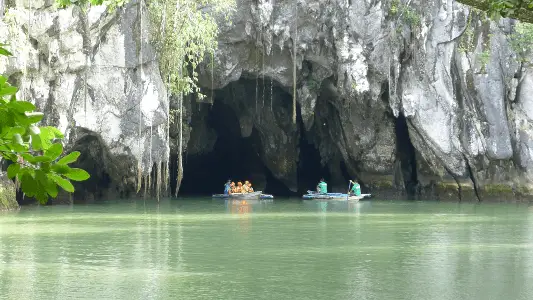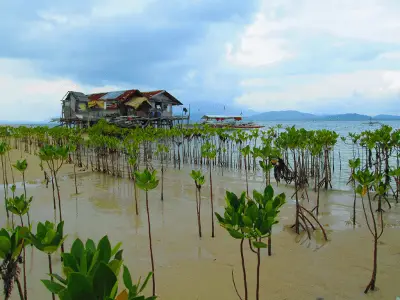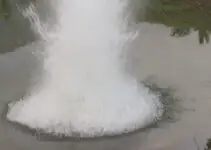What motivates people to conserve or protect natural resources? Is natural resources conservation always the economic incentive? Read on to find out.
The previous days with a documentary film crew brought me once again in close contact with nature and ponder why great efforts have been made to keep the natural environment intact in those areas that we visited. These remarkable tourist destinations include the awesome Underground River, one of the New 7 Wonders of Nature found in Puerto Princesa, west of the Philippines; the Mangrove Paddle Boat Tour forest where local folks entertain tourists while navigating a brackish water river flanked by a well-preserved mangrove forest; and yesterday in a rather unique 200 meter plus stretch of family protected coral reef in Snake Island.
Mindful of the plight of these natural wonders of nature, I explored answers to the following questions:
- What were the major reasons for conservation and protection?
- Who are the major players and their roles, and
- What are the prospects of sustainability of these natural resource-oriented activities?
I examined three levels of natural resources conservation in this article: city government, community, and family.
Economically Driven Incentive to Natural Resources Conservation: City Government and Community Level Conservation
The driving force behind the first two tourist attractions, i.e., the underground river and the pristine mangrove forest, is mainly economic. The underground river, serving as a tourist attraction, is city government managed while the mangrove paddle boat tour featuring the tall mangrove trees and mangrove wildlife is a community-based sustainable ecotourism project.
The community of Sabang, tour operators, inns and hotels, tourist guides, souvenir shops, and other tourism-oriented service providers benefit a lot from the revenue brought in by tourists willing to spend their money for the mainly aesthetic benefits given to them by the underground river.
The enjoyment of limestone formations of stalactites and stalagmites that form impressions like the holy family, the dragon’s head, “the highway”, the cacao fruit, among others, visit the underground river worthwhile.

Meanwhile, in Sabang River, tall mangrove trees that make one wonder how long they have been there, occasional encounter with a mangrove snake “sleeping” on a clump of leaves or a python nestled in a hollowed part of a mangrove branch, brackish water fishes, eel, among others, leave tourists spellbound. Their experience is further enriched by tour guides giving an entertaining trivia of information about the mangrove ecosystem.
This continuous inflow of monetary benefits encourages the local people to keep their natural environment in a state conducive enough to attract visitors. As long as the natural environment is maintained, they will have a continuous source of income. Economic sustainability is assured when natural resources conservation serve as one of the foundations of doing business.
But what if the main motive of conservation is a conviction to do so with respect to marine life? How sustainable is it?
Moral Conviction: Family Level Natural Resources Conservation
Mang Felix is probably an unsung hero of conservation who, by his own inner motivation, protected a reef patch out of moral conviction.
He settled with his family in the north end portion of Snake Island, a sandbar which gradually built up through the natural process of sedimentation. It somehow gives him assurance that his residence, despite the occasional storms that hit Honda Bay, would be a good takeoff point for his fishing activities.
He built his makeshift house next to a 200-meter stretch of coral reef in the later part of the 1980s. He rallied the support of his family of eight to keep illegal fishers from that narrow, fringing reef at the west side of their home. Even members of his family are not allowed to fish in that zone.
Although he initially joined a group of illegal fishers that destroyed most of the highly productive coral reefs of the bay in the 1970s to 80s, he thought coral reefs are homes to fishes and therefore must be spared from destructive fishing practices.
He has attended several meetings held by non-profit organizations with natural resources conservation as their main goal. Those meetings strengthened his care for nature’s continued existence to keep food on the table.
After roughly 23 years, the small fringing reef became a refuge for different fishes. Schools of sea mullet (banak) frequent a part of the protected area. Reef fishes live undisturbed amongst branching and tabulate corals.
The family benefited as they need not fish from far areas and spend a lot on fuel. They fish just around the protected zone, enjoying the spillover effects.

As a healthy coral reef abound with marine life, many fishers in nearby barangays took interest in whatever potential yield that reef could give them. They have an easily accessible fishing ground but were prevented from exploiting it because of the gregarious and adamant protection the family gave to that reef.
The intruding fishers questioned the right of Mang Felix and his family to protect that reef, who, at a certain point of time, were recognized as informal caretakers that kept the reef intact from opportunistic fishers.
There had been several attempts to dislodge the simple home in that part of Snake Island but the family remained steadfast and held on to it justifying their existence by sheer adherence to sustainable fishing methods and never “touching” the reef and admonishing others to do the same.
Several years later, however, their passive fish corral (tangkal) located a few hundred meters from their house was removed by government authorities. As a result, they lost over 50% of their livelihood source.
When asked how Mang Felix would sustain protection in the future, he said that one of his sons will continue the legacy and resist whatever attempts there may be to separate them from the reef which had become a part of their lives.
Discussion
Natural resources conservation and protection have been the focus of government, non-government or private sectors in view of sustaining the goods and services that the natural environment can provide. Sustainability is always the underlying principle of such initiatives.
Without the prospect of maintaining the integrity of natural resources and enjoying the benefits these can give, the future generations will have to suffer the consequences: loss of revenue from non-extractive economic activities like ecotourism, depletion of natural food sources, chronic poverty and hardship for small fishers and farmers as their catch dwindled, among others.
Conclusion
The two situations described in the preceding sections show how organized groups and even a family can protect natural resources. While large-scale and medium-scale ecotourism ventures appear to be more sustainable, small-scale attempts to maintenance of natural resource integrity should not be ignored.
Family-based protection, when done by many people (see Successful Family-Based Mangrove Afforestation Project) , could be more effective especially when there are enforcement problems because of corruption, lack of dedicated personnel, or funds to patrol the vast seas and isolated forest lands.
While economic benefits are strong incentives to protect natural resources, conviction and sheer love for nature can assure resource sustainability. Natural resources conservation is possible if people undergo education on the role of conservation in their economic life.
© 2023 January 29 P. A. Regoniel


